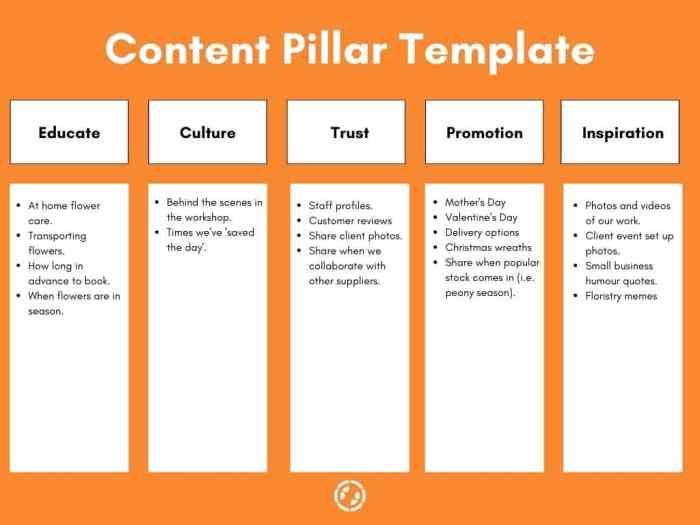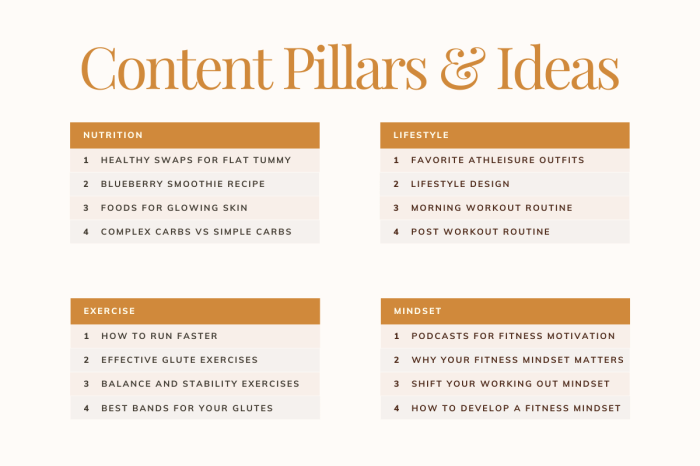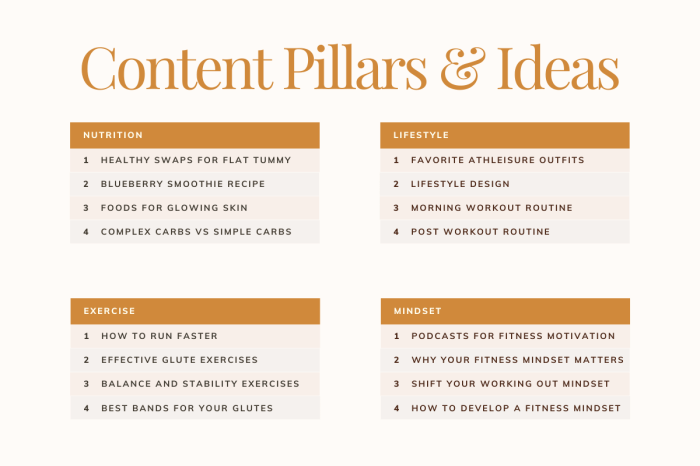Creating Content Pillars sets the stage for a strategic approach to content creation, guiding you through the process of building a robust content foundation that resonates with your audience.
As you dive into this guide, you’ll uncover the key elements needed to develop compelling content pillars that elevate your brand’s online presence.
What are Content Pillars?
Content pillars are the main topics or themes that form the foundation of a brand’s content strategy. They represent the core areas of focus that align with the brand’s values, goals, and target audience. Creating content pillars helps to streamline content creation efforts, maintain consistency in messaging, and establish a strong brand identity.
Importance of Creating Content Pillars
Content pillars are essential in content strategy as they provide a clear roadmap for creating and organizing content. By defining specific pillars, brands can ensure that their content is relevant, consistent, and engaging for their audience. Content pillars also help in establishing expertise in a particular niche or industry, attracting and retaining a loyal following.
- Increased brand visibility: Content pillars help brands to establish a strong online presence and stand out in a crowded digital landscape.
- Consistent messaging: By focusing on specific themes, brands can maintain a consistent voice and tone across all their content channels.
- Targeted audience engagement: Content pillars allow brands to tailor their content to the interests and needs of their target audience, leading to higher engagement and conversions.
Examples of Successful Content Pillars
Red Bull: Extreme sports, adventure, and adrenaline-fueled content.
Lululemon: Health, wellness, and active lifestyle content.
HubSpot: Inbound marketing, sales, and business growth content.
Identifying Core Topics
Identifying core topics relevant to your brand or niche is crucial for creating effective content pillars. These core topics should be broad enough to cover a range of s but interconnected to maintain consistency and relevance. Here are some tips on how to select core topics for your content pillars:
Selecting Broad Yet Interconnected Themes
When choosing core topics, consider the main areas of interest or expertise within your brand or niche. Look for overarching themes that can encompass a variety of related s. For example, if your brand is in the fitness industry, core topics could include nutrition, workouts, mindset, and recovery. These themes are broad enough to cover a wide range of content but interconnected enough to provide a cohesive narrative for your audience.
- Example 1: Nutrition
- Example 2: Workouts
- Example 3: Mindset
- Example 4: Recovery
Developing Pillar Content
Creating content under each pillar involves identifying key themes and topics that align with your overall content strategy. This process helps in establishing a strong foundation for your content pillars and ensures that the content resonates with your target audience.
Research and Planning
To develop pillar content, start by conducting thorough research to understand your target audience’s preferences, interests, and pain points. Use tools like research, social media analytics, and surveys to gather insights. Then, plan your content calendar by outlining the core topics for each pillar and the types of content you will create.
- Brainstorm ideas based on your research findings.
- Create a content calendar to organize your pillar content.
- Ensure alignment with your overall content strategy.
- Consider the format and distribution channels for each piece of content.
Creating Engaging Content
When creating pillar content, focus on producing high-quality, engaging pieces that provide value to your audience. Use storytelling, visuals, and interactive elements to make your content more compelling and shareable.
- Write compelling headlines and introductions to grab the audience’s attention.
- Use a mix of formats such as videos, infographics, and blog posts to keep the content diverse.
- Include actionable advice or tips that readers can apply in their lives.
- Encourage audience interaction through comments, shares, and likes.
Maintaining Consistency
Consistency is key when producing content for different pillars. It helps in building brand credibility and establishing a strong online presence. To maintain consistency, create style guides, templates, and editorial calendars to ensure that your content follows a cohesive voice and style.
- Establish brand guidelines for tone, voice, and visual elements.
- Use templates for blog posts, social media posts, and other content formats.
- Stick to a regular posting schedule to keep your audience engaged.
- Review and analyze your content performance regularly to make adjustments as needed.
Pillar Interlinking: Creating Content Pillars

Interlinking content within pillars is crucial for creating a strong and cohesive website structure. By connecting related topics together, you can improve the user experience and help search engines better understand the relevance and context of your content.
Importance of Interlinking
Interlinking helps search engines crawl and index your site more effectively, which can positively impact your efforts. When you link relevant content together, you are essentially telling search engines that these pages are related and should be considered as valuable resources on a particular topic. This can improve your site’s authority and visibility in search results.
- Interlinking also enhances the user experience by guiding visitors to other relevant and valuable content on your site. This can increase engagement, reduce bounce rates, and encourage users to spend more time exploring your site.
- By strategically interlinking your content, you can create a logical flow of information for users, making it easier for them to navigate through different topics and find the information they are looking for.
- Additionally, interlinking can help distribute link equity throughout your site, boosting the value of all interconnected pages and improving your overall site’s authority.
Best Practices for Interlinking
- Use descriptive anchor text: When interlinking, make sure to use relevant and descriptive anchor text that gives users a clear idea of what to expect when they click on the link.
- Link to relevant content: Ensure that the content you are linking to is closely related to the topic at hand, providing additional value and context for users.
- Avoid overlinking: While interlinking is important, it’s essential to strike a balance and not overwhelm your content with too many links. Focus on quality over quantity.
- Update and maintain links: Regularly review your interlinking strategy to ensure that all links are working correctly and pointing to the most relevant and up-to-date content on your site.
Updating and Refreshing Pillar Content

Updating and refreshing pillar content is crucial to maintaining relevance and driving traffic to your website over time. As trends evolve and new information becomes available, it’s important to keep your pillar content up-to-date to ensure it remains valuable to your audience.
Significance of Updating and Refreshing
- Updating content helps improve search engine rankings by showing search engines that your site is active and relevant.
- Refreshing content allows you to incorporate new data, trends, and insights to provide your audience with the most current information.
- Regularly updating pillar content can help attract returning visitors who are looking for fresh insights and perspectives.
Strategies for Keeping Content Relevant
- Monitor industry trends and news to identify opportunities for updating your pillar content with the latest information.
- Regularly review and revise your content to ensure it aligns with your audience’s needs and interests.
- Utilize analytics data to identify top-performing pillar content and prioritize updates based on performance metrics.
Repurposing Existing Content for Better Engagement
- Transform existing pillar content into different formats such as videos, infographics, or podcasts to reach a wider audience.
- Create updated versions of popular pillar content with new insights and perspectives to keep your audience engaged.
- Link related pillar content together to create a cohesive and interconnected content ecosystem that encourages readers to explore more of your website.
Measuring Pillar Performance
In order to track the success of your content pillars, it’s essential to monitor key metrics that indicate their performance. By analyzing these metrics, you can gain valuable insights into what is working well and what areas need improvement.
Key Metrics for Tracking Pillar Performance
- Organic Traffic: Monitor the amount of organic traffic each pillar page receives to gauge its visibility and relevance to your target audience.
- Engagement Metrics: Look at metrics like average time on page, bounce rate, and social shares to understand how engaging your pillar content is.
- Conversion Rates: Measure how many visitors from pillar pages convert into leads or customers to assess their impact on your business goals.
- Backlink Profile: Keep track of the number and quality of backlinks pointing to your pillar content to evaluate its authority and value.
Tools and Methods for Analyzing Pillar Performance
Utilize tools like Google Analytics, SEMrush, Ahrefs, and HubSpot to gather data on traffic, engagement, and conversions for each pillar page. Conduct A/B testing and heat mapping to further analyze user behavior and optimize pillar content performance.
Optimizing Pillar Strategies with Data-Driven Insights, Creating Content Pillars
Data-driven insights from the metrics mentioned above can help you refine your content pillar strategies. For example, if you notice a high bounce rate on a particular pillar page, you can experiment with different CTAs or content formats to improve engagement. By continuously analyzing data and making data-driven decisions, you can ensure your content pillars remain effective and relevant to your audience.
